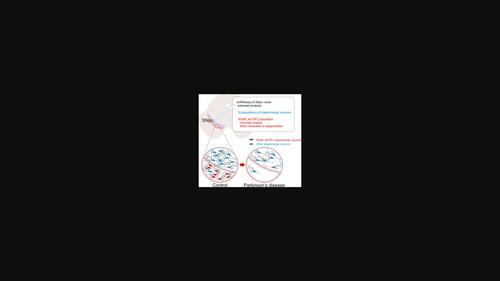Movement Disorders ( IF 7.4 ) Pub Date : 2022-06-29 , DOI: 10.1002/mds.29137 Jose L Labandeira-Garcia 1 , Juan A Parga 1

|
Kamath, T, Abdulraouf, A, Burris, SJ, et al. Single-cell genomic profiling of human dopamine neurons identifies a population that selectively degenerates in Parkinson's disease. Nat Neurosci 2022; 25( 5): 588– 595.
The loss of dopaminergic neurons in the substantia nigra pars compacta (SNpc) is the neuropathological hallmark of Parkinson's disease (PD). However, neurons in the ventral tier of the SNpc are more vulnerable than those in the dorsal tier. The mechanism responsible for differences in vulnerability of dopaminergic neurons is a central and long-standing question in the field of PD, because the answer may lead to major therapeutic advances. The heterogeneous composition of the SNpc neuron population has been further demonstrated with new single-cell genomic methods.
Kamath et al1 used single-nucleus RNA sequencing and unbiased clustering analysis of human SNpc dopaminergic neurons to define 10 transcriptionally distinct subpopulations, observing similar results in different mammalian species. One population, characterized by high levels of expression of both SOX6 and the angiotensin receptor type 1 (AGTR1) genes, was specifically located in the ventral tier of the SNpc of healthy control subjects, where neurodegeneration is more prominent in PD. In addition, the SOX6_AGTR1 subpopulation showed the largest loss of neurons when comparing patients with PD or Lewy body dementia with control subjects, and AGTR1 expression correlated with susceptibility to neurodegeneration. SNpc dopaminergic neurons, but not other cell populations, showed an enrichment of genes associated with increased PD risk, suggesting a cell-intrinsic mechanism. This enrichment appears related to the SOX6_AGTR1 neuron subtype, which showed the largest increase. Moreover, the SOX6_AGTR1 subpopulation expressed lower levels of genes regulated by the dopaminergic-differentiation transcription factor LMX1A, but overexpressed TP53 and NR2F2, which are involved in dopaminergic neurodegeneration. The causal relationship between gene expression and dopaminergic vulnerability has not been clarified.
However, the findings are consistent with those of previous studies in PD models suggesting a major role of the brain renin-angiotensin system (RAS) in promoting dopaminergic neurodegeneration by activation of the pro-oxidative and proinflammatory AGTR1.2, 3 Furthermore, an intracellular RAS was identified in mitochondria and nuclei of dopaminergic neurons, including other RAS components such as AGTR2 and MAS receptors that may counteract the deleterious effects of AGTR1 activation.4 Recent clinical studies also support a neuroprotective effect of AGTR1 inhibitors.3, 5 The findings of Kamath et al1 further encourage the development of prodromal clinical trials for angiotensin receptor blockers (ARBS) that can cross the blood-brain barrier or for molecules inhibiting AGTR1 effects, including those acting on RAS regulatory components (AGTR2, MAS) that counteract AGTR1 activation. Furthermore, their results may also improve PD cell therapies by neuroprotecting or selectively replacing the most vulnerable cells.
中文翻译:

帕金森病中退化的黑质神经元表达血管紧张素受体 1 型基因
Kamath,T,Abdulraouf,A,Burris,SJ,等。人类多巴胺神经元的单细胞基因组分析确定了一个在帕金森病中选择性退化的群体。Nat 神经科学 2022;25 ( 5 ): 588 – 595。
黑质致密部 (SNpc) 中多巴胺能神经元的丧失是帕金森病 (PD) 的神经病理学标志。然而,SNpc 腹侧的神经元比背侧的神经元更脆弱。导致多巴胺能神经元脆弱性差异的机制是 PD 领域的一个中心和长期存在的问题,因为答案可能会导致重大的治疗进展。新的单细胞基因组方法进一步证明了 SNpc 神经元群的异质组成。
卡马斯等人1使用单核 RNA 测序和人类 SNpc 多巴胺能神经元的无偏聚类分析来定义 10 个转录不同的亚群,在不同哺乳动物物种中观察到相似的结果。一个以 SOX6 和 1 型血管紧张素受体 (AGTR1) 基因的高水平表达为特征的人群专门位于健康对照受试者 SNpc 的腹侧层,其中神经变性在 PD 中更为突出。此外,在将 PD 或路易体痴呆患者与对照受试者进行比较时,SOX6_AGTR1 亚群显示出最大的神经元损失,并且 AGTR1 表达与对神经变性的易感性相关。SNpc 多巴胺能神经元,但不是其他细胞群,显示出与 PD 风险增加相关的基因富集,提示细胞内在机制。这种富集似乎与 SOX6_AGTR1 神经元亚型有关,显示出最大的增加。此外,SOX6_AGTR1 亚群表达受多巴胺能分化转录因子 LMX1A 调节的基因水平较低,但过表达参与多巴胺能神经变性的 TP53 和 NR2F2。基因表达与多巴胺能脆弱性之间的因果关系尚未阐明。
然而,这些发现与先前在 PD 模型中的研究结果一致,表明脑肾素-血管紧张素系统 (RAS) 通过激活促氧化和促炎 AGTR1 在促进多巴胺能神经变性中的主要作用。2, 3此外,在多巴胺能神经元的线粒体和细胞核中发现了一种细胞内 RAS,包括其他 RAS 成分,例如 AGTR2 和 MAS 受体,它们可能抵消 AGTR1 激活的有害影响。4最近的临床研究也支持 AGTR1 抑制剂的神经保护作用。3, 5 Kamath 等人的发现1进一步鼓励开发可以穿过血脑屏障的血管紧张素受体阻滞剂 (ARBS) 或抑制 AGTR1 作用的分子的前驱临床试验,包括那些作用于 RAS 调节成分 (AGTR2、MAS) 以抵消 AGTR1 激活的分子。此外,他们的结果还可以通过神经保护或选择性替换最脆弱的细胞来改善 PD 细胞疗法。











































 京公网安备 11010802027423号
京公网安备 11010802027423号